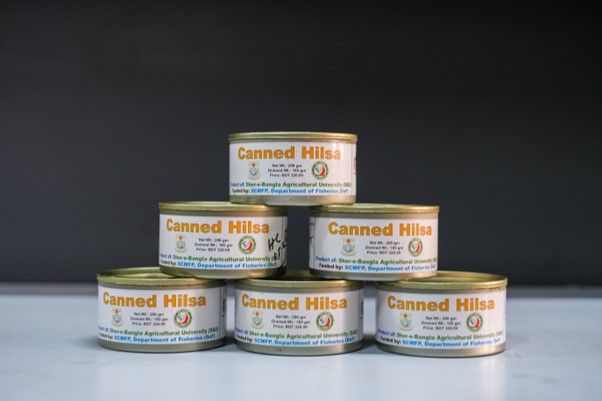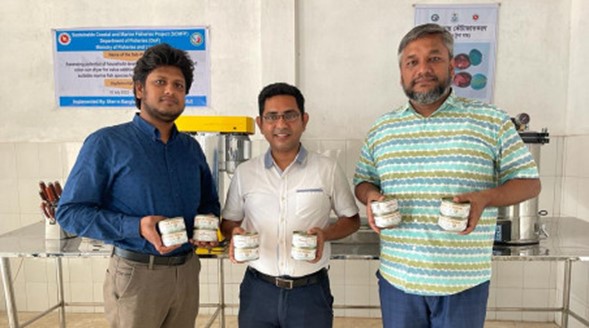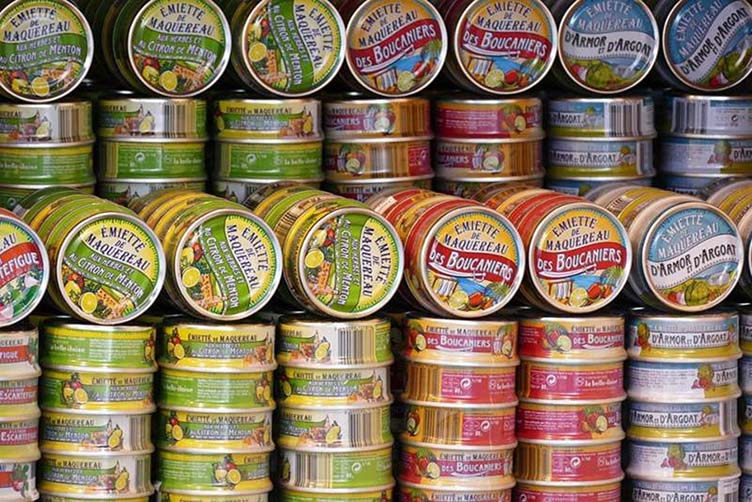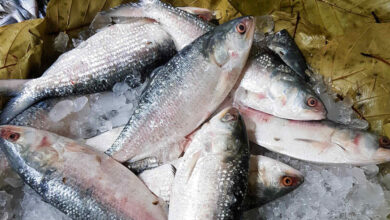
Canned fish is a convenient dish that is used by people all over the world for quick and hassle-free meals. Instead of needing to be prepared and cooked like fresh fish, canned food is ready to consume right away. Although it is a standard practice in many nations, Bangladesh has not historically used this kind of fish marketing. Only canned tuna is available in the country but in a limited quantity.
However, recently researchers from the Sher-e-Bangla Agricultural University (SAU) have invented locally produced canned “Shorshe Ilish” (Tenualosa Ilisha) that is chemical-free and will be sold for a reasonable price.
The research was supported by the Sustainable Coastal and Marine Fisheries Project of the Department of Fisheries, and supervised by Professor Dr. Kazi Ahsan Habib, the department’s chairman and head of the fisheries biology and genetics department at SAU.
The canned hilsa project was piloted by a private company called Sagar Fish Export. The owner, Abed Ahsan Sagar, established a piloting facility on a small plot of land in Cox’s Bazar’s North Nuniar Chala.

However, Bangladesh is home to 260 freshwater and 475 marine fish species. And Rui (Labeo rohita), Pangas (Pangasius), and Tilapia (Oreochromis mossambicus) are among the most widely consumed species of fish. So, the question remains why Hilsa (Tenualosa ilisha) is to be canned?
Several factors are driving the canning of hilsa, including its enormous popularity in Bangladesh as the national fish.
Due to its distinctive flavor and smell, hilsa is often referred to as the “king of fishes.” Moreover, hilsa is abundant only in a few nations, including Bangladesh. And Bangladesh is where more than 80% of the world’s Hilsa is produced. Additionally, this fish has a high demand all around the world.

A second reason for putting hilsa in the can was that the fish can’t be preserved for a long time. Hilsa can’t be dried because it has too much fat. So, the shop owners put salt on the extra fish to keep it fresh longer. But salty hilsa is not worth nearly as much as fresh hilsa. And salty hilsa is not in the best shape to be exported to other countries. Even when it is frozen, it is hard to export hilsa. So, in these situations, the hilsa that comes in a can might be a better choice.
Additionally, Bangladesh produces enormous hilsa in the peak seasons. For example, more than 0.55 million tons of hilsa were produced in the 202–21 fiscal year. The high output rate, however, is not always advantageous to the poor fishermen. Most of the middlemen stockpile enormous quantities of fresh hilsa during the peak of harvest and sell the leftovers for a premium price. They give the fishermen a little sum of money.
“Industrial canning of hilsa may assist the fishers get reasonable prices for the extra catches,” said Md Masud Rana, co-researcher and assistant professor of fishing and post-harvest technology at SAU.
“The reason we looked into canning fish was to keep the costly but perishable hilsa around for a long time while keeping international standards. While doing so, we wanted people from every aspect to be able to buy our best fish all year long,” he added.
The canned hilsa produced by SAU researchers costs BDT 320 (around USD 3). There are four fish slices in the singular container. In addition, only hilsa weighing between 600 and 700 grams will be canned. They are currently testing three recipes: mustard hilsa, chili hilsa, and vegetables with hilsa that do not contain any spices. The last item is for international consumers. Currently, the product has an expiration life of three months.
Is the price accessible to all? According to the researchers, they have set the price after conducting all necessary economic analysis.
Due to a chemical reaction between the fatty acid in the fish and the tin, hilsa cannot be canned in locally available jars. Therefore, the researchers imported cans with a layer of zinc oxide between the aluminum and the fish.
“The price will be reduced even further if containers are produced locally. Even a rickshaw puller will be able to afford tinned hilsa more than once per month.,” said Masud,
Experts believe, the industrialization of canned hilsa will create more new jobs in Bangladesh.
Jaber Bin Abdul Bari
Department of Oceanography, NSTU




